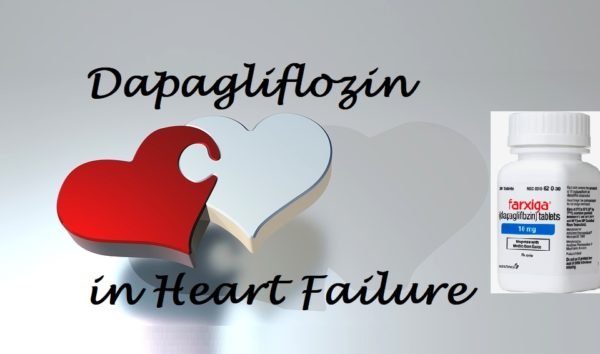Dapagliflozin (Forxiga) is an SGLT2 inhibitor (sodium-glucose co-transporter 2 inhibitor) that is being used to treat patients with Diabetes Mellitus Type 2. It has also been recently approved in obese patients with Type 1 Diabetes Mellitus who have an inadequate glycemic control and are at low risk of ketoacidosis. It has also been studied in patients without Diabetes Mellitus who have kidney disease or heart failure.
Dapagliflozin for Heart Failure with reduced Ejection Fraction:
In patients with Diabetes Type 2 and heart failure, dapagliflozin has been proven to reduce hospitalization. However, the role of dapagliflozin in non-diabetic patients with heart failure was not known until the DAPA-HF trial.
The DAPA-HF Trial [Ref]:
The DAPA-HF trial evaluated the role of dapagliflozin in nearly 5000 patients who were:
- older than 18 years of age,
- had an ejection fraction of 40% or less
- Had NYHA class II, III, or IV symptoms
- Had a plasma NT-ProBNP of at least 600 pg/ml OR a plasma NT-ProBNP of at least 400 pg/ml in individuals with a history of hospitalization for heart failure over the past one year
- Patients with atrial flutter or atrial fibrillation on baseline EKG were required to have a NT-ProBNP of at least 900 pg/ml regardless of their history of hospitalization.
Patients were required to receive treatment as follows:
- Standard heart failure device therapy in the form of an implantable cardioverter-defibrillator, cardiac resynchronization therapy, or both AND
- Standard heart failure treatment including:
- an ACE-inhibitor or ARBs containing medicines as:
- an angiotensin-converting–enzyme inhibitor, OR
- an angiotensin-receptor blocker, OR
- Sacubitril–valsartan
- PLUS:
- a Beta-Blocker (unless contraindicated)
- The use of mineralocorticoid receptor antagonist was also encouraged
- an ACE-inhibitor or ARBs containing medicines as:
- Patients with type 2 Diabetes Mellitus were continued on anti-diabetic medications and their dosages adjusted as indicated.
The following groups of patients were not included in the study:
- Patients who had received SGLT-2 inhibitors recently or were intolerant to SGLT-2 inhibitors
- Diabetes Mellitus Type 1
- Hypotensive patients or those with a systolic blood pressure of less than 95 mmHg
- eGFR of less than 30 ml/min/1.73m² or individuals with a rapidly declining renal functions
All the patients were divided into two groups. One group received Dapagliflozin at a dose of 10 mg once a day and the other group received matching placebo. All the patients were assessed on the 14th day and on day 60th of initiating the treatment. The dose of dapagliflozin was reduced to 5 mg once daily in patients who reported symptoms of hypotension, volume depletion, or had an unexpected decline in GFR.
The OUTCOME of the study:
- The primary outcome of worsening heart failure or death from a cardiovascular cause occurred in 16.3% in the dapagliflozin group and 21.2% in the placebo group.
- 9.7% in the dapagliflozin vs 13.4% in the placebo group were hospitalized for heart failure.
- Death from cardiovascular causes occurred in 9.6% in the dapagliflozin group vs 11.5% in the placebo group.
- More patients reported an improvement in the symptoms of heart failure in the dapagliflozin group compared to the placebo as assessed by the Kansas City Cardiomyopathy Questionnaire.
Outcomes of the DAPA-HF trial in non-diabetic patients:
Dapagliflozin was found to be as effective in 55% of the patients who were non-diabetic. In patients without diabetes, the primary composite outcome (a composite of hospitalization for heart failure, an urgent visit resulting in intravenous therapy for heart failure, or death from cardiovascular causes) occurred in 171 out of 1298 patients in the dapagliflozin group compared to 231 out of 1307 patients in the placebo group. Thus, dapagliflozin, and maybe other drugs from the same class of medicines like empagliflozin, canagliflozin, and ertugliflozin may have a therapeutic role in non-diabetic patients with heart failure.
Dapagliflozin in heart failure - Expert recommendations:
Dapagliflozin is recommended for patients with heart failure with reduced ejection fraction (HFrEF) who have persistent symptoms and elevated serum natriuretic peptide levels despite optimal drug therapy (Class IB recommendation). The mechanism of improved cardiovascular outcomes and especially in reducing the risks of hospitalization from heart failure has not been fully elucidated. However, one mechanism could be the effect of volume depletion as a result of osmotic diuresis and natriuresis. The question arises then, why not increase the dose of furosemide or aldosterone receptor antagonist? In diabetic patients, adding an SGLT-2 inhibitor like dapagliflozin or empagliflozin will definitely reduce the requirements of antidiabetic medicines especially insulin and sulfonylureas. Since insulin (and sulfonylureas) has a dose-dependent anti-natriuretic effect, the addition of dapagliflozin in the treatment of diabetic patients with heart failure will have a double impact - Insulin dose reduction minimizing the anti-natriuretic effect and the osmotic diuretic effect. In non-diabetic patients, the use of dapagliflozin in heart failure patients with reduced ejection fraction may need further studies and active comparison with diuretics and mineralocorticoid agents as an active comparator.







